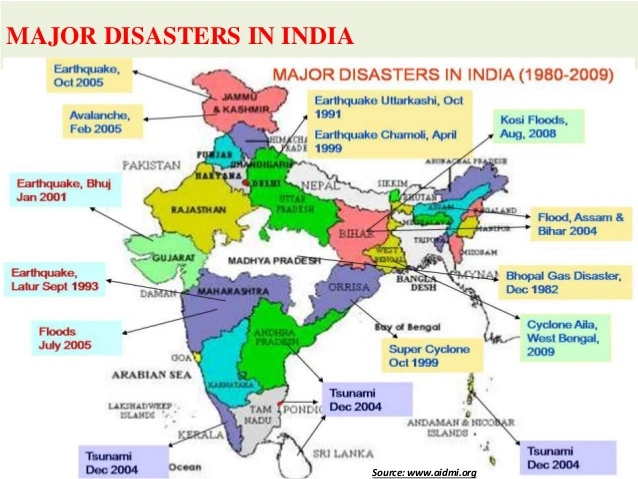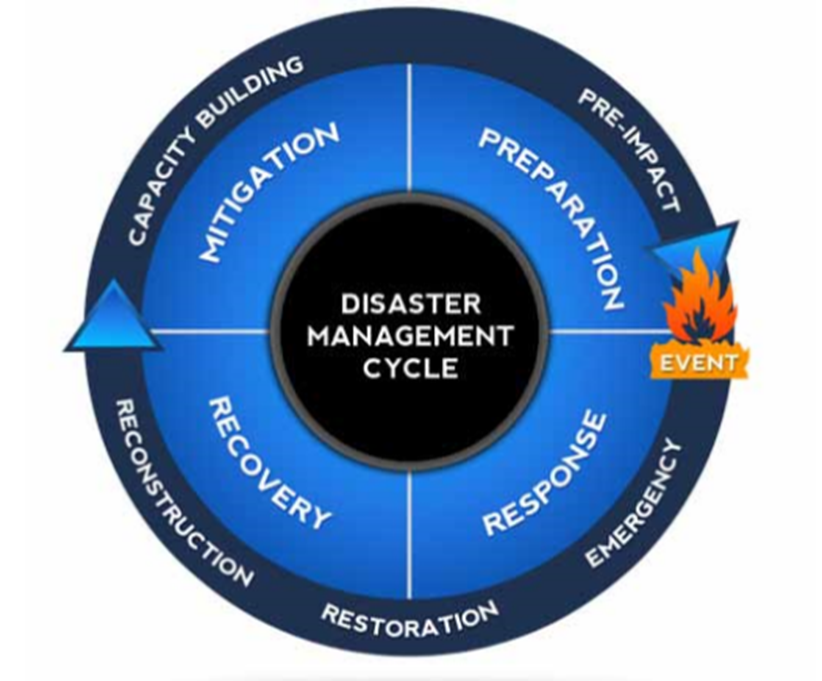PREVIOUS
Disaster Management – Part I
November 29 , 2019
2239 days
15657
0
- Natural hazard causes injury or loss of life, damage to property, social or economic disruption and environmental degradation.
- For India, the major hazards are Earth quakes, Landslides, Drought, Cyclones, Floods, Forest fires and other Fire accidents.
- According to World Bank report, India's direct loss due to disaster is around 2% of its GDP.
- Also, according to the United Nations International Strategy for Disaster Reduction (UNISDR) in 2010, India is ranked second after China for natural disasters.
- According to National Crime Records Bureau data, India’s record is appalling on fire safety. More than 17,000 people nationwide died in fire related incidences in 2015.
- These tragedies highlight the gaps in Disaster Management framework of India.
- In this context, there is a need to understand the various facets of Disaster Management.
- October 29 – National Day for Disaster Reduction.
Disaster – Definition
- Disaster is an event or series of events, which gives rise to casualties and damage or loss of properties, infrastructures, environment, essential services or means of livelihood on such a scale which is beyond the normal capacity of the affected community to cope with.
- The United Nations defines disaster as “the occurrence of sudden or major misfortune which disrupts the basic fabric and normal functioning of the society or community”.
- A disaster is a serious disruption occurring over a short or long period of time that causes widespread human, material, economic or environmental loss which exceeds the ability of the affected community or society to cope using its own resources.
- A disaster is a result of natural or man-made causes that leads to sudden disruption of normal life.
- It is an undesirable occurrence resulting from forces that are largely outside human control.
Classification of Disasters
- Disasters are classified as per origin, into natural and man-made disasters.
- As per severity, disasters are classified as minor or major (in impact).
- Natural disasters are sudden ecological disruptions or threats that exceed the adjustment capacity of the affected community and require external assistance.
- Natural disasters can be broadly classified into categories
- geophysical such as earthquakes and volcanic eruptions;
- hydrological such as floods;
- meteorological such as hurricanes;
- climatological such as heat and cold waves and droughts;
- biological such as epidemics.
- Natural disasters can be broadly classified into categories
- Man-made disasters can include hazardous material spills, fires, groundwater contamination, transportation accidents, structure failures, mining accidents, explosions and acts of terrorism.
Causes for Occurrence of Disaster
- Environmental degradation:
- Removal of trees and forest cover, soil erosion, expansion of flood plain area and groundwater depletion.
- Developmental process:
- Exploitation of land use, development of infrastructure, rapid urbanization and technological development over the natural resources.
- Political issues:
- War, nuclear power aspirations, fight between countries. These have resulted into wide range of disaster events such as Hiroshima nuclear explosion, Syrian civil war.
- Industrialization:
- This has resulted into warming of earth and frequency of extreme weather events has also increased.
Impacts of Disaster
- Disaster impacts individuals physically (through loss of life, injury, health, disability) as well as psychologically.
- Disaster results in huge economic loss due to destruction of property, human settlements and infrastructure etc.
- Disaster can alter the natural environment, loss of habitat to many plants and animals and cause ecological stress.
- After natural disasters, food and other natural resources like water often becomes scarce resulting into food and water scarcity.
- The disaster results in displacement of people, and displaced population often face several challenges in new settlements.
Vulnerability Profile of India
- India is vulnerable, in varying degrees, to a large number of disasters.
- Around 59% of the landmass is prone to earthquakes of moderate to very high intensity.
- About 12% (over 40 million hectares) of its land is prone to floods and river erosion.
- Close to 5,700 kms, out of the 7,516 kms long coastline is prone to cyclones and tsunamis.
- 68% of its cultivable area is vulnerable to droughts; and, the hilly areas are at risk from landslides and avalanches.
- Moreover, India is also vulnerable to Chemical, Biological, Radiological and Nuclear (CBRN) emergencies and other man-made disasters.
- Disaster risks in India are further compounded by increasing vulnerabilities related to changing demographics and socio-economic conditions, unplanned urbanization, development within high-risk zones, environmental degradation, climate change, geological hazards, epidemics and pandemics.
- Clearly, all these contribute to a situation where disasters seriously threaten India’s economy, its population and sustainable development.
Worst Disasters in India
- Kerala Floods (2019) - due to heavy rainfall in the Monsoon season,121 people have been killed & Over 2 lakh people have been directly affected by the flood.
- Kashmir Floods (2014) - have resulted into death of more than 500 people.
- Uttarakhand Flash Floods (2013) - resulted into death of more than 5,000 people.
- The Indian Ocean Tsunami (2004) affected parts of southern India and Andaman Nicobar Islands, Sri Lanka, Indonesia etc., and resulted in the death of more than 2 lakh people.
- Gujarat Earthquake (2001) - resulted in death of more than 20,000 people.
- Odisha Super Cyclone or Paradip cyclone (1999) - resulted into death of more than 10,000 people.
- Bhopal Gas tragedy (December, 1984) is one of the worst chemical disasters globally that resulted in over 10,000 losing their lives and over 5.5 lakh persons affected and suffering from agonizing injuries.
- The Great Famine (1876-1878) affected Madras, Mysore, Hyderabad, and Bombay and resulted into death of around 3 crore people.
- Even today, it is considered as one of the worst natural calamities in India of all time.
- The Bengal Famine in the years 1770 and 1943 affected Bengal, Odisha, Bihar very badly and resulted into death of nearly 1 crore people.

- In recent times, there have been
- cases of railway accidents (Dussehra gathering on the railway tracks crushed by the trains in 2018),
- fire accidents in hospitals due to negligence and non-implementation of existing mandatory fire safety norms,
- Stampede at large public gathering like Kumbh Mela caused by poor people management and lack of adequate infrastructure.
Stages in Disaster Management
- Disaster Management efforts are geared towards disaster risk management.
- Disaster Risk Management implies the systematic process of using administrative decisions, organisation, operational skills, and capacities to implement policies, strategies and coping capacities of the society and communities to lessen the impact of natural hazards and related environmental and technological disasters.
- These comprise all forms all activities including structural and non- structural measures to avoid (prevention) or to limit (mitigation and preparedness) adverse effects of hazards.
- There are three key stages of activities in disaster management:
- Before a disaster: to reduce the potential for human, material, or environmental losses caused by hazards.
- During a disaster: to ensure that the needs and provisions of victims are met to alleviate and minimise suffering.
- After a disaster: to achieve rapid and durable recovery which does not reproduce the original vulnerable conditions.
- The different phases of disaster management are represented in the disaster cycle diagram.

Disaster Risk Reduction (DRR)
- Disaster risk reduction is the concept and practice of reducing disaster risks through systematic efforts to analyse and reduce the causal factors of disasters.
- Pre-Disaster risk reduction includes-
- Mitigation: To eliminate or reduce the impacts and risks of hazards through proactive measures taken before an emergency or disaster occurs.
- Preparedness: To take steps to prepare and reduce the effects of disasters.
- Post-Disaster risk reduction includes-
- Rescue: Providing warning, evacuation, search, rescue, providing immediate assistance.
- Relief: To respond to communities who become victims of disaster, providing relief measures such as food packets, water, medicines, temporary accommodation, relief camps etc.
- Recovery: This stage emphasises upon recovery of victims of disaster, recovery of damaged infrastructure and repair of the damages caused.
Challenges in Disaster Risk Reduction
- There are insufficient levels of implementation for each monitored activity.
- For example, Disaster risk management plans or a risk sensitive building codes exist but they are not enforced because of a lack of government capacity or public awareness.
- There is lack of local capacities to implement disaster risk management.
- Absence of integration of climate change into Disaster risk management plans.
- There is divergence of obtaining political and economic commitments due to other competing needs and priorities such as poverty reduction, social welfare, education etc. require greater attention and funding.
- Due to poor coordination between stakeholders, there is inadequate access with respect to risk assessment, monitoring, early warning, disaster response and other Disaster related activities.
- Insufficient investment in building disaster resilient strategies, also private sector are least contributors in the share of investment.
ó ó ó ó ó ó ó ó ó ó
Leave a Reply
Your Comment is awaiting moderation.


